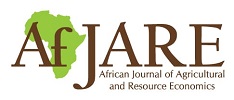
Supports Open Access
0.5 Impact Factor



African Journal of Agricultural and Resource Economics (AfJARE)
A publication of the African Association of Agricultural Economists (AAAE)
Latest Publications
Influence of dissemination pathways on the adoption of circular economy practices among coconut farmers in Kilifi County, Kenya:A duration analysis approach
The underutilisation of coconut and its by-products imply poor livelihoods and, ultimately food insecurity for farmers growing coconut. Sustainable practices like a circular economy (CE) need to be promoted for uptake by the farmers to achieve sustainable development through better utilisation of coconuts and their by-products.
Impact of sustainable intensification technologies on farm income among rural households: Empirical evidence from Dedza district, Malawi
This study examined the effect of sustainable intensification (SI) technologies, specifically the use of improved maize seed varieties, of improved bean seed varieties (Nua45), crop rotation, maize-legume intercropping and doubled-up legume systems on farm income in Dedza district, Malawi.
Are all farmers technically inefficient? Evidence from smallholder rice producers in Ghana
This study applied the zero-inefficiency stochastic frontier (ZISF) to analyse the technical efficiency of 333 improved rice-farming households for the 2012/2013 farming season in Ghana.
Food price shocks and living standards of rural households in Senegal: Do non-farm diversification strategies matter?
This study examines the effects of rising food prices on rural household living standards, with a particular focus on the moderating role of non-farm diversification.
Effet de la participation aux chaînes de valeur mondiales sur la productivité agricole en Afrique de l’Ouest
Bien que l’économie africaine en général et celle de l’Afrique de l’ouest en particulier demeure fortement dépendante du secteur agricole, ce dernier s’avère être le moins productif parmi les trois grands secteurs considérés de l’économie, notamment le secteur agricole, industriel et des services.
The hazards and impacts of climate change are exacerbating. They threaten crop productivity, farmers’ resilience and the mitigation of greenhouse gas (GHG) emissions. Understanding climate-smart agriculture (CSA) and applying it is crucial.
Volume 20
Cet article analyse les effets des produits forestiers non ligneux (PFNL) sur la pauvreté multidimensionnelle au Burkina Faso. Il s'appuie sur des données primaires collectées auprès de 384 ménages sélectionnés aléatoirement.
Bien que l’économie africaine en général et celle de l’Afrique de l’ouest en particulier demeure fortement dépendante du secteur agricole, ce dernier s’avère être le moins productif parmi les trois grands secteurs considérés de l’économie, notamment le secteur agricole, industriel et des services.
Volume 19
Using the potential outcomes framework, we estimate the influence of the adoption gap, adoption drivers and impact of adopting improved groundnut varieties (IGVs) on groundnut yield among smallholder farmers in Nigeria.
Cet article analyse l’impact des chocs agro-climatiques sur la sécurité alimentaire des ménages ruraux sénégalais à l'aide d'un modèle probit ordonné. La méthode du score de consommation alimentaire est utilisée pour appréhender l'état de la sécurité alimentaire des ménages. L’étude montre que 14% des ménages vivant en milieu rural sont à consommation alimentaire faible, 17% à consommation alimentaire limite, et 69% à consommation alimentaire acceptable.
Climate change and its pronounced effects have greatly disfranchised the livelihoods of aquafarmers. To leverage these negative effects of climate change, climate-smart aquaculture (CSA) practices have been developed for adoption by farmers. However, it is not known whether these practices have made any meaningful contribution to farmers in terms of their livelihoods and resilience to the vagaries of climatic change.
Volume 18 (2023)
This study investigates the relationships between financial inclusion, gender and household welfare. We used baseline data collected from a randomised control trial survey of maize farmers in Nigeria and computed multidimensional indices for financial inclusion and farmers’ household welfare.
Uganda’s climate is changing in terms of rising temperatures and altered precipitation patterns, leading to extreme meteorological conditions such as prolonged drought, floods and landslides. Yet the majority (68%) of Ugandans rely largely on rain-fed agriculture, which is affected by climate variability.
Poultry waste management and the energy demand have generated environmental and climate change concerns. Experts have suggested converting poultry waste to biogas energy through recycling to reduce these concerns.

